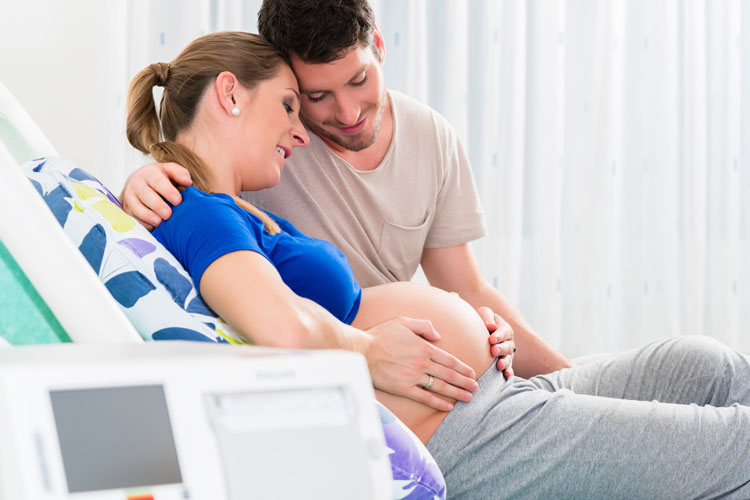Table of contents
YOUR BIRTH PLAN EXPLAINED
A birth plan is a document that lets your medical team know your preferences for things like how to manage labour pain or how you would like your baby cared for after he/she is born. Keep in mind that you cannot control every aspect of labour and delivery, and you will need to stay flexible in case something comes up that requires your birth team to depart from your plan. But a printed document gives you a place to make your wishes clear. Your doctor and midwife will be happy to assist you in preparing this document
Remember that, at any time, you can change your mind regarding your wishes.

VAGINAL DELIVERY
LABOUR & BIRTH
Environment
You are invited to visit our delivery suite prior to giving birth to better know what the hospital can offer to you
Monitoring
Every baby’s heart is monitored throughout labour. Depending of the situation, the monitoring can be intermittent or continuous. Be aware that in some cases, continuous monitoring is necessary to ensure your baby’s safety.
Pain control
There are many different ways to help you cope with the pain of labour and childbirth. These range from special breathing to an epidural block. When your pain is under control, it is easier for you to help with the birth. You may choose natural childbirth (no pain relief), but you can also opt for pain relief if the pain becomes too much for you.
Labour
If your labour is progressing too slowly, your doctor may suggest rupture of membranes or starting an intra-venous infusion with oxytocin. Oxytocin is a hormone which will cause the contractions to get stronger or become more regular.
BIRTH
Pushing time
You can indicate in your birth plan whether you prefer coached pushing or instinctive pushing.
Medical intervention
Forceps or vacuum are not routinely used however sometimes the baby’s head does not move as expected through the birth canal. If this happens, your doctor may use forceps or vacuum extraction to deliver the baby.
An episiotomy is a surgical cut that your doctor may perform in the area between the vagina and anus to avoid the risk of natural tear and enlarge the opening if baby needs it. Episiotomy is not performed routinely but your obstetrician may recommend one in some situations
Immediately after birth
After your baby is born, and the umbilical cord is cut, it is possible to collect your baby’s cord blood and cord tissues (umbilical cord) that contain special cells called stem cells which can be used for your baby’s future medical needs. If you wish to have this done, please contact our receptionist on the 1st floor to give you all the necessary information.
At FV hospital we strongly encourage placing your baby on your skin just after the birth. This skin-to-skin moment helps create the bond with your newborn baby and gives you the opportunity to start breastfeeding within the first hour of your baby.
Breastfeeding is also strongly encouraged as breast milk is the ultimate best source of nutrition for your baby
VAGINAL BIRTH AFTER C-SECTION
If you desire to try a vaginal delivery after having had a previous caesarean section, you should be encouraged by knowing that approximately 80% of women who have previously undergone caesarean birth can successfully give birth vaginally.
ELECTIVE CAESAREAN DELIVERY
An elective caesarean delivery is a scheduled C-section; it can be a patient-requested C-section or a C-section indicated for medical reasons
You can ask for your partner or a relative to be present in the operating theatre, to have photos or video taken, the type of anaesthesia, your baby’s cord blood to be collected. We encourage skin-to-skin immediately after delivery and breastfeeding within one hour after birth
Note that the presence of your partner or a relative can be refused when complications are feared or if the procedure is not going to be done under spinal/epidural anaesthesia.
IN THE MATERNITY WARD
Feeding my baby
FV Hospital recognises that breast milk is the most complete form of nutrition for infants and endorses at least six months of exclusive breastfeeding as the ideal way to feed your baby.
Our trained staff will help prepare expecting mothers and support new mothers on this journey.
Bonding
FV Hospital encourages rooming-in with your baby during your hospital stay. Rooming-in is good for both you and your baby. A mother who is rooming in is able to attend to her baby when feeding cues are displayed, helping her establish a good milk flow by promoting milk let-down.
MY BIRTH PLAN
At FV Hospital we recognise that every birthing experience is unique. We have created this document to help you plan for the various stages of your birthing experience. Please indicate below your preferences and share your plan with your obstetrician and midwife. We are looking forward to caring for you and your family during this special time and to providing you with a memorable and safe experience
We will do everything we can to honour your wishes but be aware that your safety and the safety of your baby may require unexpected change to your birth experience

I am planning:
- Vaginal Delivery
- Vaginal Birth after C-Section
- Caesarean Delivery
VAGINAL DELIVERY
LABOUR & BIRTH
Environment
- I am interested in dim lighting
- I would like music during labour
- I am planning to bring my own music with me
- I would like to watch TV during labour, show me what is available
- I would like help with limiting my visitors
- I would like my partner to be with me during labour and birth
- I would like my children to be present; I understand that another adult must supervise children under 16
- I would like to have my labour photographed or filmed
Monitoring
- I would like intermittent monitoring to allow for:
- walking
- using birthing ball
- I would prefer continuous foetal monitoring
Pain control
- I would prefer labour without pain medication – I will ask if I would like something for pain, please do not ask me
- I will decide whether to use pain medication as my labour progresses
- I would like to try other pain relief methods before trying an epidural
- I would like an epidural as soon as possible
Labour process
- I would like to have the midwife present as much as possible at bedside during labour
- I would prefer to let my water break naturally
- I would prefer not to use oxytocin
BIRTH
Pushing time
- I would like to be allowed to push when and how I feel I should
- I would like to be coached on when to push and for how long
- I would like to view my baby’s birth using a mirror
- I would like to touch my baby’s head as it crowns
Medical intervention
- Use forceps or vacuum only when medically indicated (for example if my baby shows signs of distress)
Avoid episiotomy, if possible
Immediately after birth
- I would prefer my partner to cut the umbilical cord
- I planned for my baby’s cord blood collection
- I want to hold my baby skin-to-skin immediately after delivery
- I would like for my baby’s first assessment to be done in the presence of my partner
- I would like to breastfeed within one hour after birth
ELECTIVE CAESAREAN DELIVERY
- I want my baby to be born by caesarean
- I would like a spinal/epidural anaesthesia
- I want my partner or a relative to be present in the OT room
- I want my partner/relative to take photos and/or videos
- I planned for my baby’s cord blood collection
- I want to hold my baby skin-to-skin immediately after delivery
- I would like for my baby’s first assessment to be done in the presence of my partner
- I would like to breastfeed in the recovery room, within one hour after birth
IN THE MATERNITY WARD
Feeding my baby
- I plan to breastfeed
- Do not give my baby a bottle or sugar water unless medically necessary
- I would like to be given advice on breastfeeding
- I do not want my baby to be given a pacifier
- If I am separated from my baby for medical needs I would like to express my milk and give it to my baby
- I plan to formula feed (breast milk substitute)
Bonding
- I would like my baby to room in with me
- I would like my baby to be taken care of in the nursery during the night




